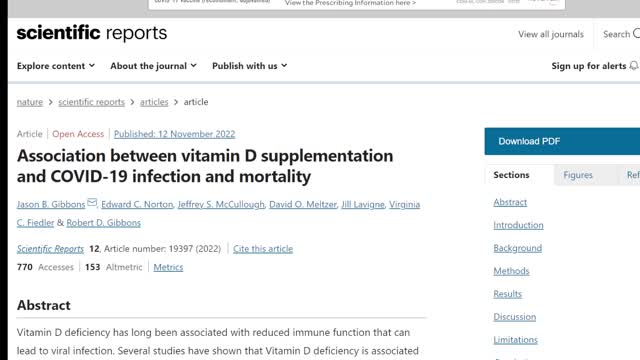Premium Only Content

Safe and effective
Association between vitamin D supplementation and COVID-19 infection and mortality
https://www.nature.com/articles/s41598-022-24053-4
(12th November 2022)
Johns Hopkins
University of Michigan
National Bureau of Economic Research
Department of Medicine, University of Chicago
Department of Veterans Health Affairs
Department of Medicine, University of Chicago, Chicago
Vitamin D deficiency, associated with reduced immune function,
can lead to viral infection
Vitamin D deficiency, associated, increases the risk of COVID-19
But is it a treatment / prognosis improver?
Population of US veterans, we show that Vitamin D2 and D3 fills
Associated with reductions in COVID-19 infection
After applying all restrictions
220,265 supplemented with vitamin D3
34,710 supplemented with vitamin D2
407,860 untreated patients.
Study design
Retrospective cohort
Supplemented (before and during the pandemic),
versus untreated controls
One to one matches
D2, D3, or calcifediol
Veterans Administration Corporate Data Warehouse (CDW) electronic health records.
Vitamin D levels typically respond to treatment following two months of exposure
D3 cohort
COVID-19 rates for the treated
= 2.66%
COVID-19 rates for the untreated = 3.30%
D3 20%, reduction
D2 28% reduction
Mortality within 30-days of COVID-19 infection
Infection ending in mortality within 30 days
D3 group
Treated group death rate after infection = 0.23%
Untreated group death rate after infection = 0.35%
Vitamin D3 33% mortality lower (HR, 67%)
P < 0.001
Vitamin D2 25% lower (HR, 75%) (but not significant)
Veterans receiving higher dosages of Vitamin D obtained greater benefits from supplementation than veterans receiving lower dosages.
Vitamin D blood levels between 0 and 19 ng/ml,
exhibited the largest decrease in COVID-19 infection and mortality following supplementation
(0–19 ng/ml, 20–39 ng/ml, and 40 + ng/ml)
Dosage options, 20 IU, 40 IU, 100 IU, 125 IU, 200 IU, 250 IU, 400 IU, 500 IU, 800 IU, 1000 IU, 2000 IU, 5000 IU, 8000 IU, and 50,000 IU
Black veterans received greater associated COVID-19 risk reductions,
with supplementation than White veterans
As a safe, widely available, and affordable treatment, Vitamin D may help to reduce the severity of the COVID-19 pandemic.
More background
Vitamin D insufficiency and deficiency affect approximately half of the US population,
with increased rates in people with darker skin,
reduced sun exposure,
people living in higher latitudes in the winter,
nursing home residents,
and healthcare workers
Populations with low levels of Vitamin D have also experienced higher rates of COVID-19
New mechanism
Vitamin D is needed to allow T helper cells to control and reduce Interferon gamma (IFN-γ) production
Conclusions
These associated reductions in risk are substantial and justify more significant exploration and confirmation using RCTs.
This is particularly important given the high rates of vitamin D deficiency in the US population and COVID-19.
Extrapolate, D3 supplementation to the entire US population in 2020
4 million fewer COVID-19 cases (19,860,000 actual cases)
116,000 deaths avoided (351,999 actual deaths)
Given our findings,
the absence of severe side effects,
the widespread availability of vitamin D3 at low cost,
vitamin D3 presents a unique opportunity to reduce the spread and severity of the COVID-19 pandemic.
K2, MK-7
Supplement, probably 100 micrograms per day
Nato, 1,000 micrograms per 100 g
Cheese, typically 50 micrograms per 100 g
Safe and effective
UK, GP incentives to vaccinate
Home, £30
Standard reimbursement to Primary Care Networks (which then gets passed to GPs) £15
New contract, £12.58 each
-
 18:05
18:05
Dr. John Campbell
1 month agoMore cancers after covid vaccines
18K61 -
 50:27
50:27
Sarah Westall
3 hours agoMusk Helps Expose the Most Consequential Political Blackmail Operation in Modern British History
9.1K9 -
 LIVE
LIVE
Due Dissidence
12 hours agoTrump GOES NUCLEAR on MTG, Tucker Exposes Butler COVERUP, Shmuley SUED For HILARIOUS Reason
1,393 watching -
 20:13
20:13
RealReaper
7 hours ago $0.35 earnedPredator Badlands: If You Like This Movie Then I Hate You
8.85K9 -
 LIVE
LIVE
GritsGG
5 hours ago#1 Most Warzone Wins 4000+!
183 watching -
 41:54
41:54
Nicholas Bowling
6 hours ago $0.31 earnedWhile Preaching to Muslims, EX-MUSLIM Shares Why He Left Islam (London, UK)
9.15K8 -
 2:25:28
2:25:28
bucketofish
3 hours agoNoise Floor \\ Behind the Mix - Ep 002 - Wide Awake by Katy Perry
15.7K1 -
 3:07:04
3:07:04
Biscotti-B23
3 hours ago $2.05 earned🔴 LIVE DISPATCH PLAYTHROUGH & PARTY GAMES
14.7K -
 LIVE
LIVE
Lofi Girl
2 years agoSynthwave Radio 🌌 - beats to chill/game to
82 watching -
 3:23:11
3:23:11
LumpyPotatoX2
5 hours agoHostile Takeover | High-Stakes PvP - #RumbleGaming
20.8K3